Nursing Intervention Assignment 2022
VerifiedAdded on 2022/10/11
|9
|2319
|12
Assignment
AI Summary
Contribute Materials
Your contribution can guide someone’s learning journey. Share your
documents today.
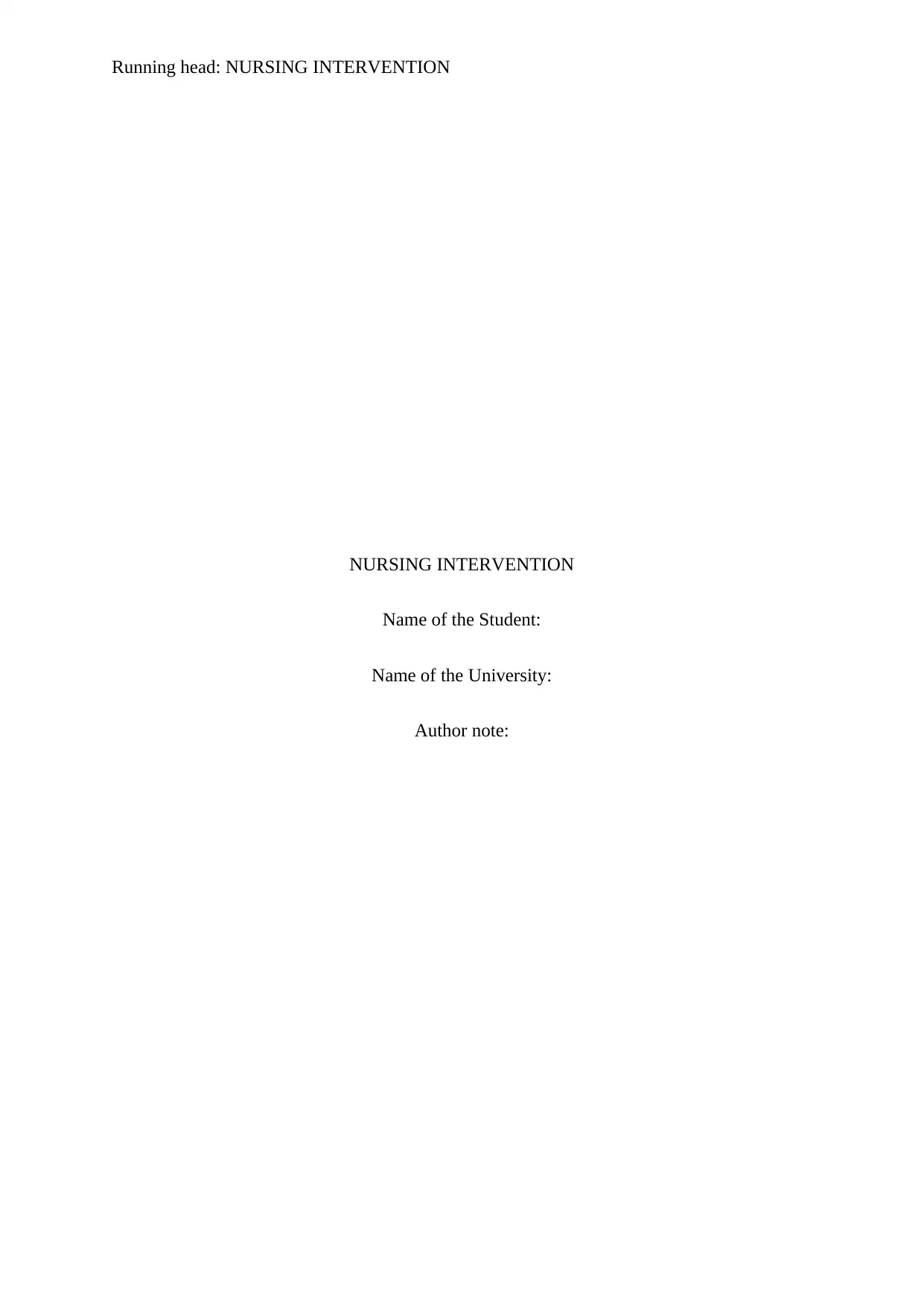
Running head: NURSING INTERVENTION
NURSING INTERVENTION
Name of the Student:
Name of the University:
Author note:
NURSING INTERVENTION
Name of the Student:
Name of the University:
Author note:
Secure Best Marks with AI Grader
Need help grading? Try our AI Grader for instant feedback on your assignments.
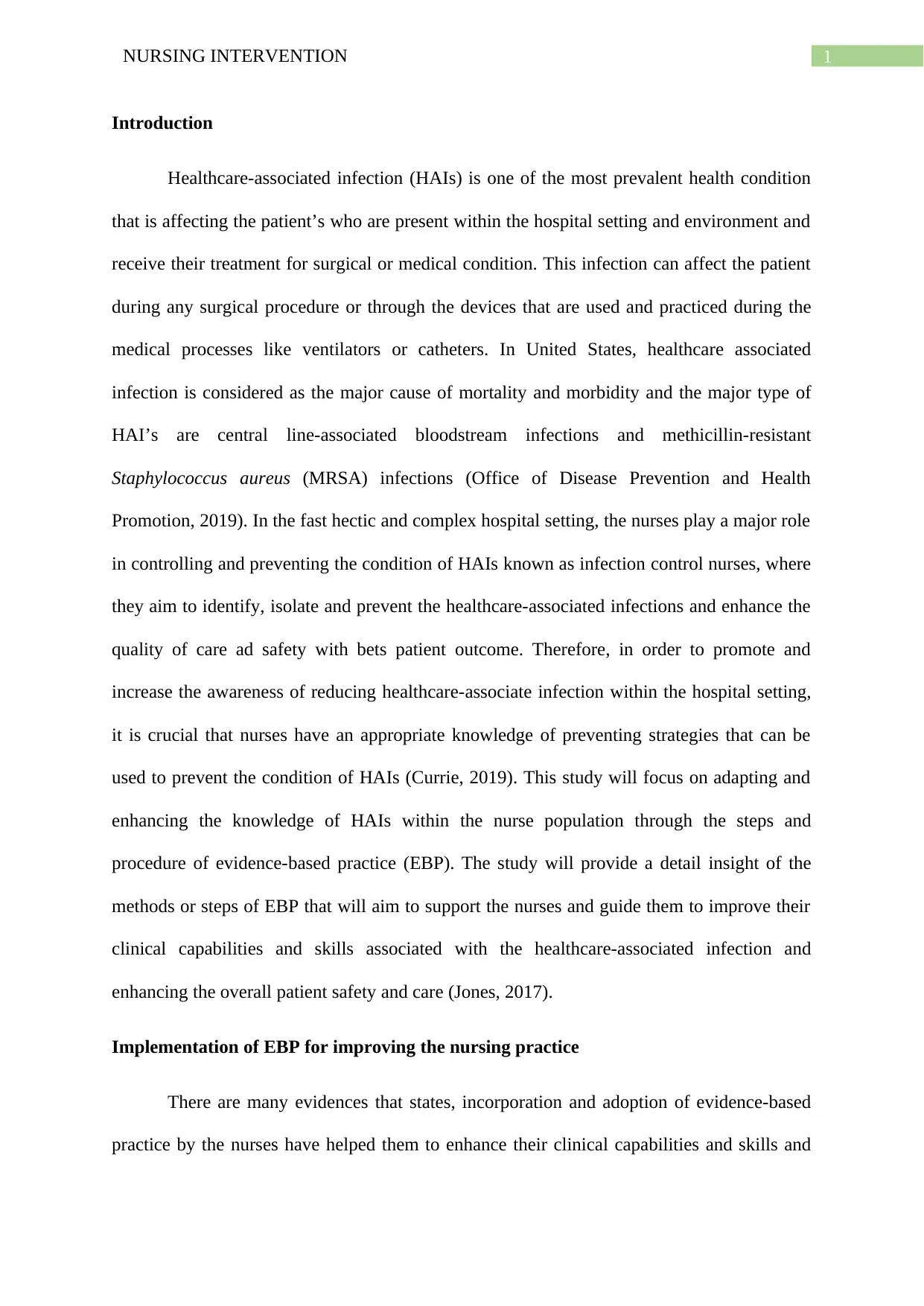
1NURSING INTERVENTION
Introduction
Healthcare-associated infection (HAIs) is one of the most prevalent health condition
that is affecting the patient’s who are present within the hospital setting and environment and
receive their treatment for surgical or medical condition. This infection can affect the patient
during any surgical procedure or through the devices that are used and practiced during the
medical processes like ventilators or catheters. In United States, healthcare associated
infection is considered as the major cause of mortality and morbidity and the major type of
HAI’s are central line-associated bloodstream infections and methicillin-resistant
Staphylococcus aureus (MRSA) infections (Office of Disease Prevention and Health
Promotion, 2019). In the fast hectic and complex hospital setting, the nurses play a major role
in controlling and preventing the condition of HAIs known as infection control nurses, where
they aim to identify, isolate and prevent the healthcare-associated infections and enhance the
quality of care ad safety with bets patient outcome. Therefore, in order to promote and
increase the awareness of reducing healthcare-associate infection within the hospital setting,
it is crucial that nurses have an appropriate knowledge of preventing strategies that can be
used to prevent the condition of HAIs (Currie, 2019). This study will focus on adapting and
enhancing the knowledge of HAIs within the nurse population through the steps and
procedure of evidence-based practice (EBP). The study will provide a detail insight of the
methods or steps of EBP that will aim to support the nurses and guide them to improve their
clinical capabilities and skills associated with the healthcare-associated infection and
enhancing the overall patient safety and care (Jones, 2017).
Implementation of EBP for improving the nursing practice
There are many evidences that states, incorporation and adoption of evidence-based
practice by the nurses have helped them to enhance their clinical capabilities and skills and
Introduction
Healthcare-associated infection (HAIs) is one of the most prevalent health condition
that is affecting the patient’s who are present within the hospital setting and environment and
receive their treatment for surgical or medical condition. This infection can affect the patient
during any surgical procedure or through the devices that are used and practiced during the
medical processes like ventilators or catheters. In United States, healthcare associated
infection is considered as the major cause of mortality and morbidity and the major type of
HAI’s are central line-associated bloodstream infections and methicillin-resistant
Staphylococcus aureus (MRSA) infections (Office of Disease Prevention and Health
Promotion, 2019). In the fast hectic and complex hospital setting, the nurses play a major role
in controlling and preventing the condition of HAIs known as infection control nurses, where
they aim to identify, isolate and prevent the healthcare-associated infections and enhance the
quality of care ad safety with bets patient outcome. Therefore, in order to promote and
increase the awareness of reducing healthcare-associate infection within the hospital setting,
it is crucial that nurses have an appropriate knowledge of preventing strategies that can be
used to prevent the condition of HAIs (Currie, 2019). This study will focus on adapting and
enhancing the knowledge of HAIs within the nurse population through the steps and
procedure of evidence-based practice (EBP). The study will provide a detail insight of the
methods or steps of EBP that will aim to support the nurses and guide them to improve their
clinical capabilities and skills associated with the healthcare-associated infection and
enhancing the overall patient safety and care (Jones, 2017).
Implementation of EBP for improving the nursing practice
There are many evidences that states, incorporation and adoption of evidence-based
practice by the nurses have helped them to enhance their clinical capabilities and skills and
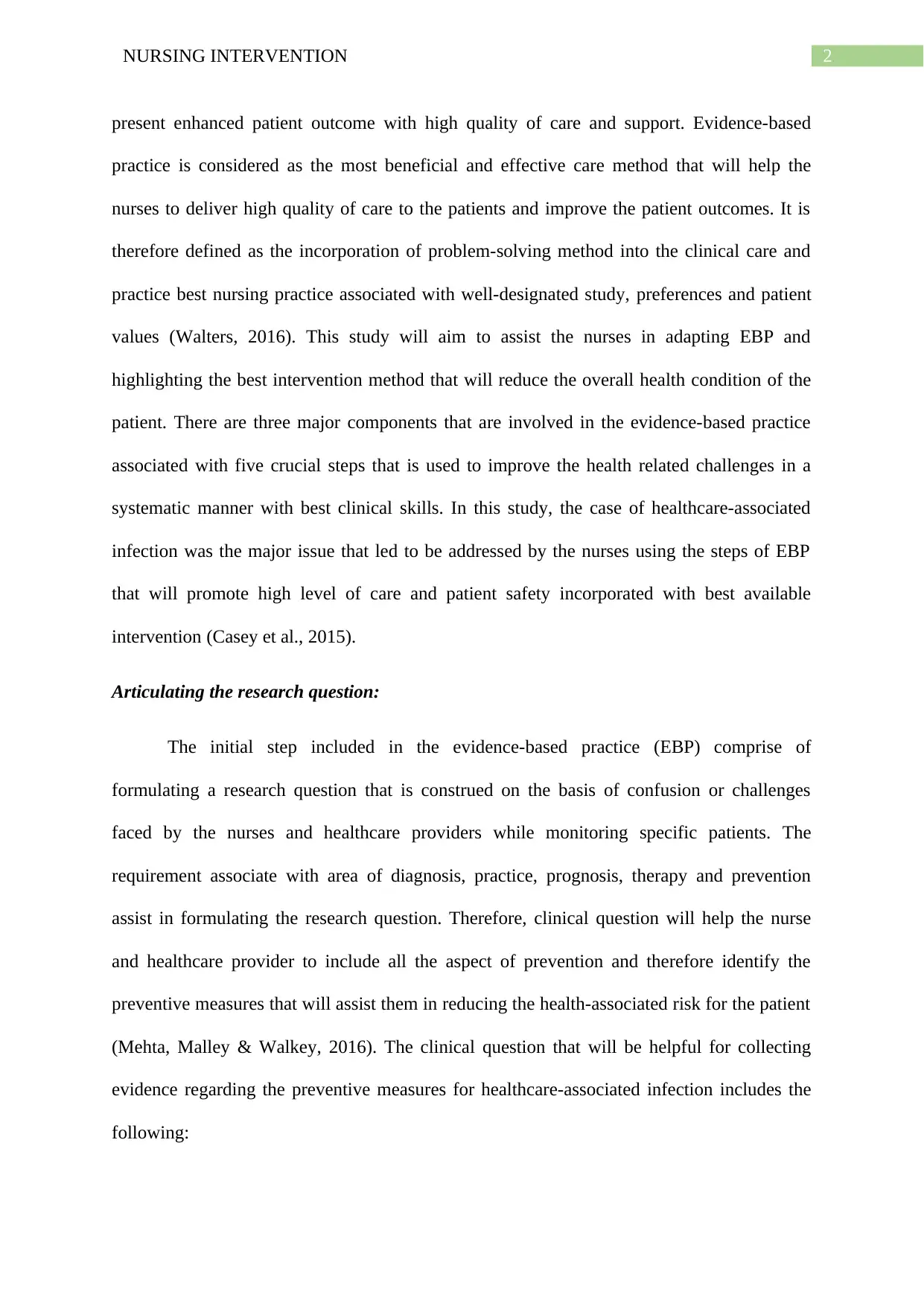
2NURSING INTERVENTION
present enhanced patient outcome with high quality of care and support. Evidence-based
practice is considered as the most beneficial and effective care method that will help the
nurses to deliver high quality of care to the patients and improve the patient outcomes. It is
therefore defined as the incorporation of problem-solving method into the clinical care and
practice best nursing practice associated with well-designated study, preferences and patient
values (Walters, 2016). This study will aim to assist the nurses in adapting EBP and
highlighting the best intervention method that will reduce the overall health condition of the
patient. There are three major components that are involved in the evidence-based practice
associated with five crucial steps that is used to improve the health related challenges in a
systematic manner with best clinical skills. In this study, the case of healthcare-associated
infection was the major issue that led to be addressed by the nurses using the steps of EBP
that will promote high level of care and patient safety incorporated with best available
intervention (Casey et al., 2015).
Articulating the research question:
The initial step included in the evidence-based practice (EBP) comprise of
formulating a research question that is construed on the basis of confusion or challenges
faced by the nurses and healthcare providers while monitoring specific patients. The
requirement associate with area of diagnosis, practice, prognosis, therapy and prevention
assist in formulating the research question. Therefore, clinical question will help the nurse
and healthcare provider to include all the aspect of prevention and therefore identify the
preventive measures that will assist them in reducing the health-associated risk for the patient
(Mehta, Malley & Walkey, 2016). The clinical question that will be helpful for collecting
evidence regarding the preventive measures for healthcare-associated infection includes the
following:
present enhanced patient outcome with high quality of care and support. Evidence-based
practice is considered as the most beneficial and effective care method that will help the
nurses to deliver high quality of care to the patients and improve the patient outcomes. It is
therefore defined as the incorporation of problem-solving method into the clinical care and
practice best nursing practice associated with well-designated study, preferences and patient
values (Walters, 2016). This study will aim to assist the nurses in adapting EBP and
highlighting the best intervention method that will reduce the overall health condition of the
patient. There are three major components that are involved in the evidence-based practice
associated with five crucial steps that is used to improve the health related challenges in a
systematic manner with best clinical skills. In this study, the case of healthcare-associated
infection was the major issue that led to be addressed by the nurses using the steps of EBP
that will promote high level of care and patient safety incorporated with best available
intervention (Casey et al., 2015).
Articulating the research question:
The initial step included in the evidence-based practice (EBP) comprise of
formulating a research question that is construed on the basis of confusion or challenges
faced by the nurses and healthcare providers while monitoring specific patients. The
requirement associate with area of diagnosis, practice, prognosis, therapy and prevention
assist in formulating the research question. Therefore, clinical question will help the nurse
and healthcare provider to include all the aspect of prevention and therefore identify the
preventive measures that will assist them in reducing the health-associated risk for the patient
(Mehta, Malley & Walkey, 2016). The clinical question that will be helpful for collecting
evidence regarding the preventive measures for healthcare-associated infection includes the
following:
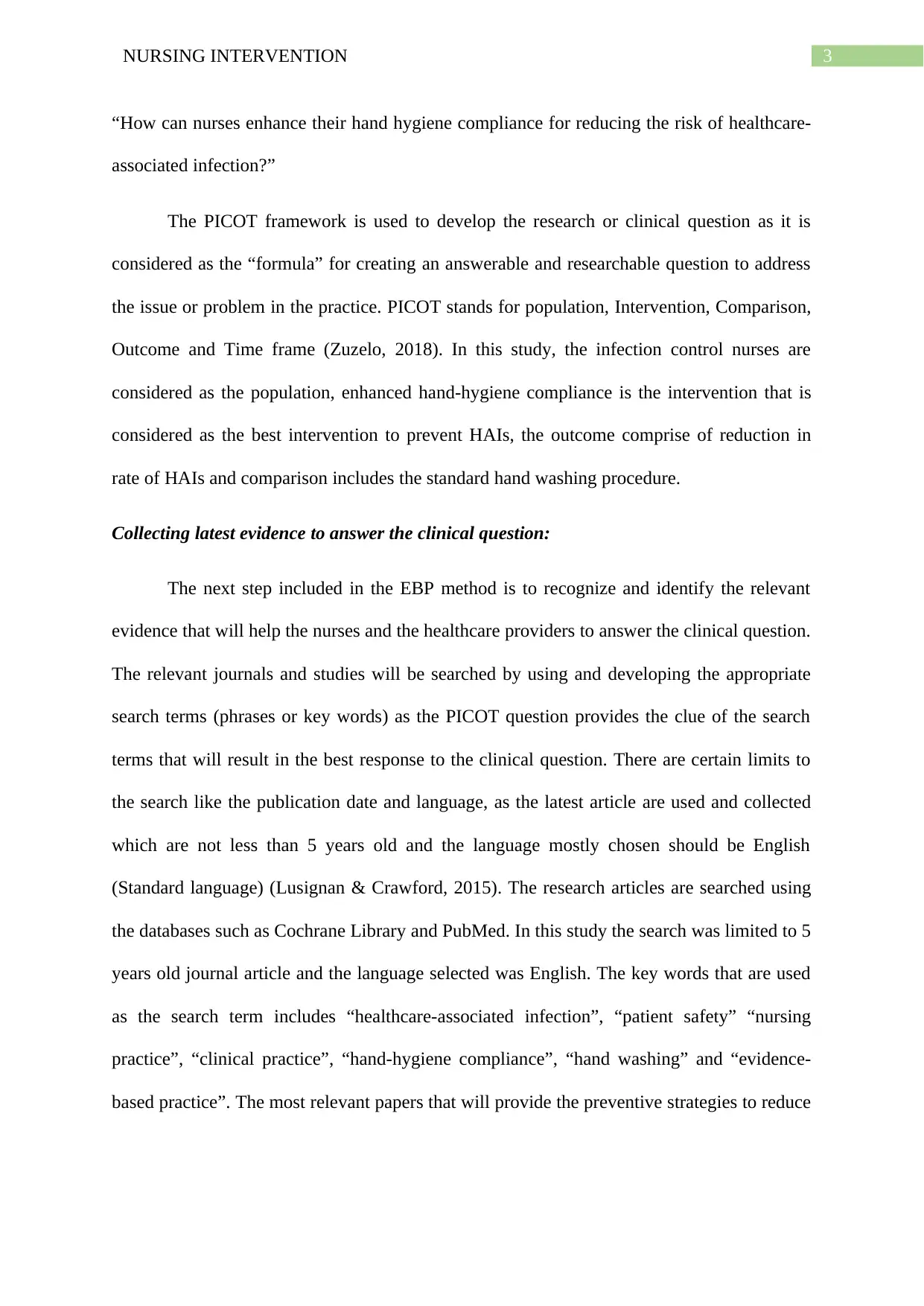
3NURSING INTERVENTION
“How can nurses enhance their hand hygiene compliance for reducing the risk of healthcare-
associated infection?”
The PICOT framework is used to develop the research or clinical question as it is
considered as the “formula” for creating an answerable and researchable question to address
the issue or problem in the practice. PICOT stands for population, Intervention, Comparison,
Outcome and Time frame (Zuzelo, 2018). In this study, the infection control nurses are
considered as the population, enhanced hand-hygiene compliance is the intervention that is
considered as the best intervention to prevent HAIs, the outcome comprise of reduction in
rate of HAIs and comparison includes the standard hand washing procedure.
Collecting latest evidence to answer the clinical question:
The next step included in the EBP method is to recognize and identify the relevant
evidence that will help the nurses and the healthcare providers to answer the clinical question.
The relevant journals and studies will be searched by using and developing the appropriate
search terms (phrases or key words) as the PICOT question provides the clue of the search
terms that will result in the best response to the clinical question. There are certain limits to
the search like the publication date and language, as the latest article are used and collected
which are not less than 5 years old and the language mostly chosen should be English
(Standard language) (Lusignan & Crawford, 2015). The research articles are searched using
the databases such as Cochrane Library and PubMed. In this study the search was limited to 5
years old journal article and the language selected was English. The key words that are used
as the search term includes “healthcare-associated infection”, “patient safety” “nursing
practice”, “clinical practice”, “hand-hygiene compliance”, “hand washing” and “evidence-
based practice”. The most relevant papers that will provide the preventive strategies to reduce
“How can nurses enhance their hand hygiene compliance for reducing the risk of healthcare-
associated infection?”
The PICOT framework is used to develop the research or clinical question as it is
considered as the “formula” for creating an answerable and researchable question to address
the issue or problem in the practice. PICOT stands for population, Intervention, Comparison,
Outcome and Time frame (Zuzelo, 2018). In this study, the infection control nurses are
considered as the population, enhanced hand-hygiene compliance is the intervention that is
considered as the best intervention to prevent HAIs, the outcome comprise of reduction in
rate of HAIs and comparison includes the standard hand washing procedure.
Collecting latest evidence to answer the clinical question:
The next step included in the EBP method is to recognize and identify the relevant
evidence that will help the nurses and the healthcare providers to answer the clinical question.
The relevant journals and studies will be searched by using and developing the appropriate
search terms (phrases or key words) as the PICOT question provides the clue of the search
terms that will result in the best response to the clinical question. There are certain limits to
the search like the publication date and language, as the latest article are used and collected
which are not less than 5 years old and the language mostly chosen should be English
(Standard language) (Lusignan & Crawford, 2015). The research articles are searched using
the databases such as Cochrane Library and PubMed. In this study the search was limited to 5
years old journal article and the language selected was English. The key words that are used
as the search term includes “healthcare-associated infection”, “patient safety” “nursing
practice”, “clinical practice”, “hand-hygiene compliance”, “hand washing” and “evidence-
based practice”. The most relevant papers that will provide the preventive strategies to reduce
Secure Best Marks with AI Grader
Need help grading? Try our AI Grader for instant feedback on your assignments.
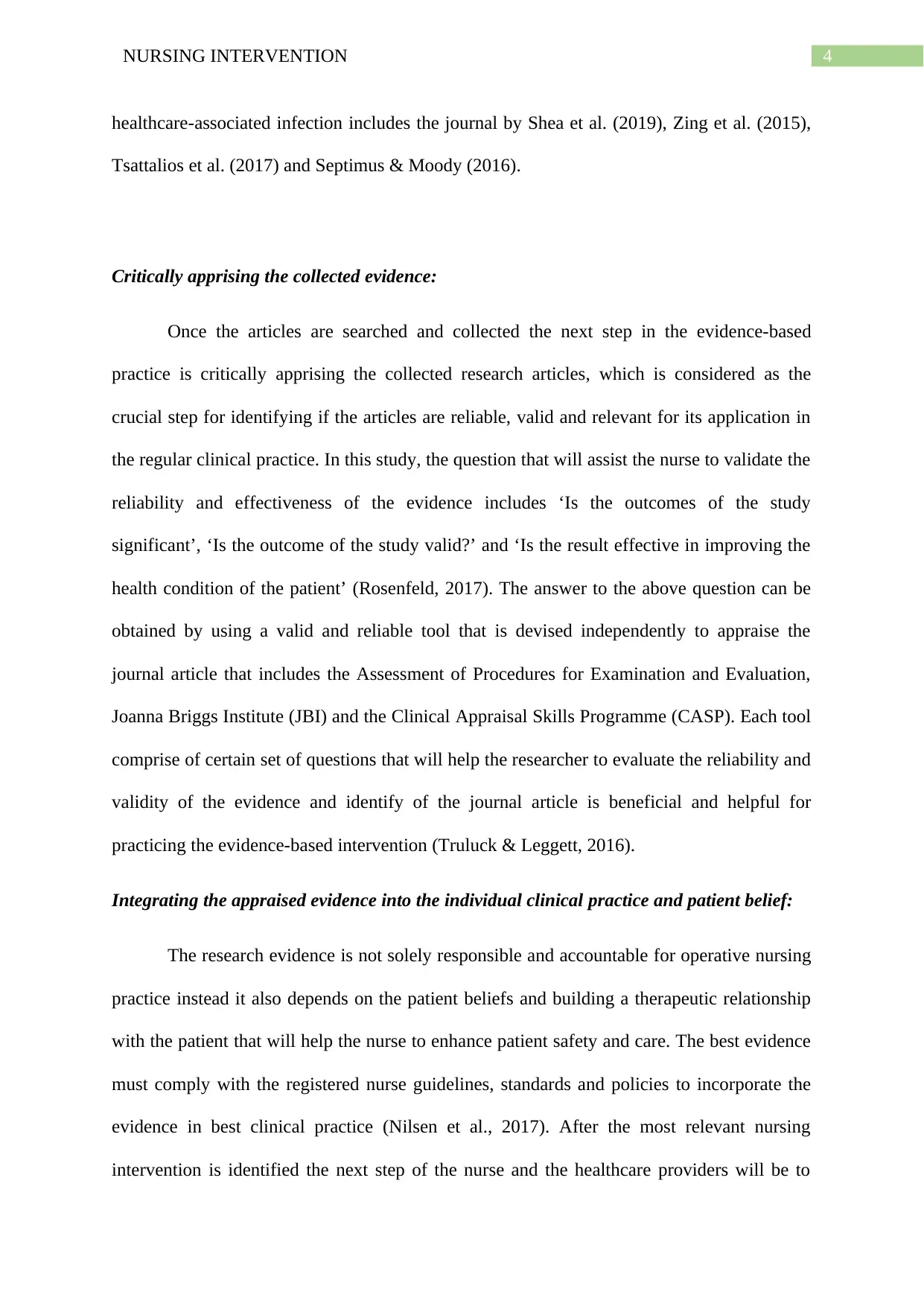
4NURSING INTERVENTION
healthcare-associated infection includes the journal by Shea et al. (2019), Zing et al. (2015),
Tsattalios et al. (2017) and Septimus & Moody (2016).
Critically apprising the collected evidence:
Once the articles are searched and collected the next step in the evidence-based
practice is critically apprising the collected research articles, which is considered as the
crucial step for identifying if the articles are reliable, valid and relevant for its application in
the regular clinical practice. In this study, the question that will assist the nurse to validate the
reliability and effectiveness of the evidence includes ‘Is the outcomes of the study
significant’, ‘Is the outcome of the study valid?’ and ‘Is the result effective in improving the
health condition of the patient’ (Rosenfeld, 2017). The answer to the above question can be
obtained by using a valid and reliable tool that is devised independently to appraise the
journal article that includes the Assessment of Procedures for Examination and Evaluation,
Joanna Briggs Institute (JBI) and the Clinical Appraisal Skills Programme (CASP). Each tool
comprise of certain set of questions that will help the researcher to evaluate the reliability and
validity of the evidence and identify of the journal article is beneficial and helpful for
practicing the evidence-based intervention (Truluck & Leggett, 2016).
Integrating the appraised evidence into the individual clinical practice and patient belief:
The research evidence is not solely responsible and accountable for operative nursing
practice instead it also depends on the patient beliefs and building a therapeutic relationship
with the patient that will help the nurse to enhance patient safety and care. The best evidence
must comply with the registered nurse guidelines, standards and policies to incorporate the
evidence in best clinical practice (Nilsen et al., 2017). After the most relevant nursing
intervention is identified the next step of the nurse and the healthcare providers will be to
healthcare-associated infection includes the journal by Shea et al. (2019), Zing et al. (2015),
Tsattalios et al. (2017) and Septimus & Moody (2016).
Critically apprising the collected evidence:
Once the articles are searched and collected the next step in the evidence-based
practice is critically apprising the collected research articles, which is considered as the
crucial step for identifying if the articles are reliable, valid and relevant for its application in
the regular clinical practice. In this study, the question that will assist the nurse to validate the
reliability and effectiveness of the evidence includes ‘Is the outcomes of the study
significant’, ‘Is the outcome of the study valid?’ and ‘Is the result effective in improving the
health condition of the patient’ (Rosenfeld, 2017). The answer to the above question can be
obtained by using a valid and reliable tool that is devised independently to appraise the
journal article that includes the Assessment of Procedures for Examination and Evaluation,
Joanna Briggs Institute (JBI) and the Clinical Appraisal Skills Programme (CASP). Each tool
comprise of certain set of questions that will help the researcher to evaluate the reliability and
validity of the evidence and identify of the journal article is beneficial and helpful for
practicing the evidence-based intervention (Truluck & Leggett, 2016).
Integrating the appraised evidence into the individual clinical practice and patient belief:
The research evidence is not solely responsible and accountable for operative nursing
practice instead it also depends on the patient beliefs and building a therapeutic relationship
with the patient that will help the nurse to enhance patient safety and care. The best evidence
must comply with the registered nurse guidelines, standards and policies to incorporate the
evidence in best clinical practice (Nilsen et al., 2017). After the most relevant nursing
intervention is identified the next step of the nurse and the healthcare providers will be to
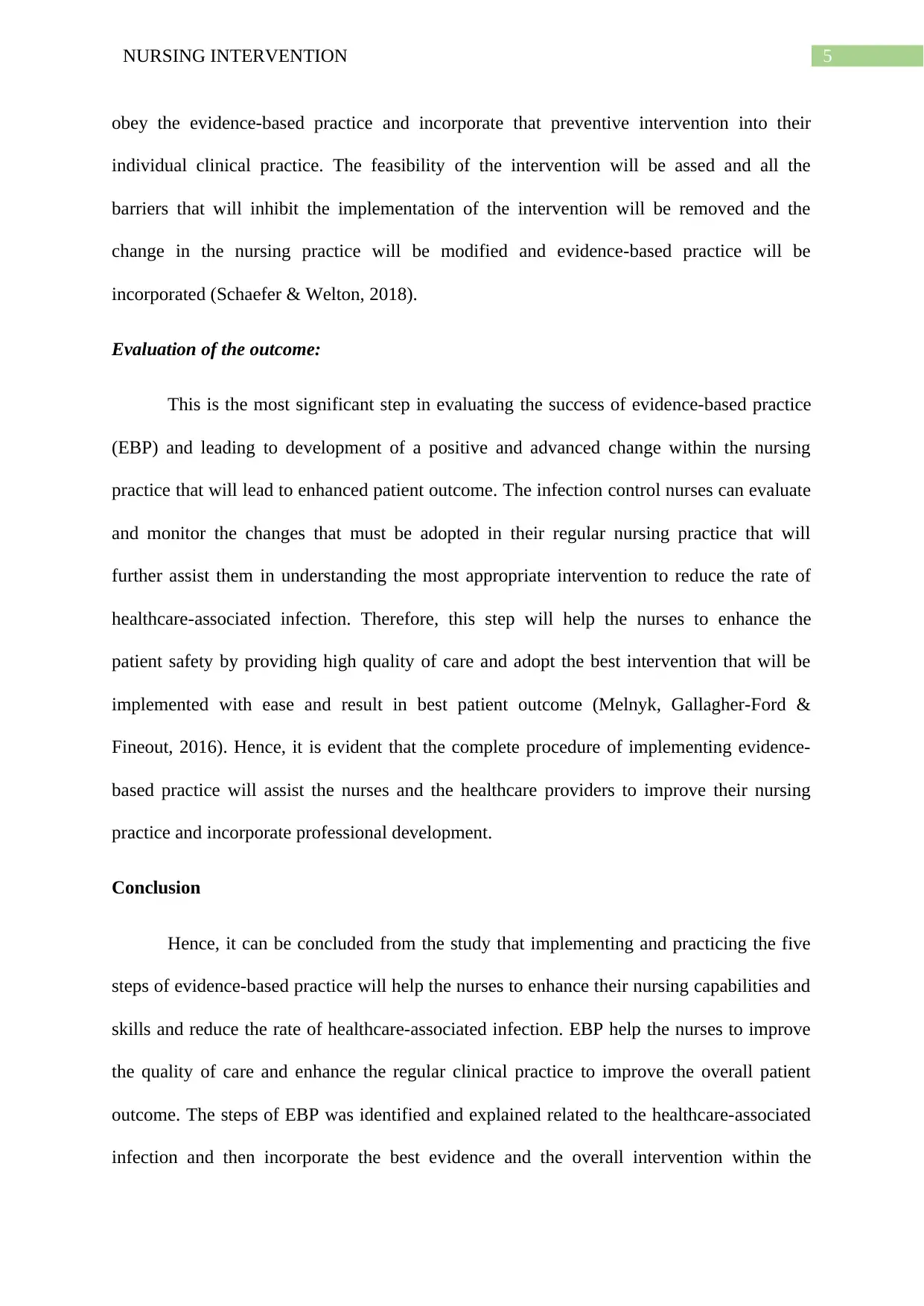
5NURSING INTERVENTION
obey the evidence-based practice and incorporate that preventive intervention into their
individual clinical practice. The feasibility of the intervention will be assed and all the
barriers that will inhibit the implementation of the intervention will be removed and the
change in the nursing practice will be modified and evidence-based practice will be
incorporated (Schaefer & Welton, 2018).
Evaluation of the outcome:
This is the most significant step in evaluating the success of evidence-based practice
(EBP) and leading to development of a positive and advanced change within the nursing
practice that will lead to enhanced patient outcome. The infection control nurses can evaluate
and monitor the changes that must be adopted in their regular nursing practice that will
further assist them in understanding the most appropriate intervention to reduce the rate of
healthcare-associated infection. Therefore, this step will help the nurses to enhance the
patient safety by providing high quality of care and adopt the best intervention that will be
implemented with ease and result in best patient outcome (Melnyk, Gallagher-Ford &
Fineout, 2016). Hence, it is evident that the complete procedure of implementing evidence-
based practice will assist the nurses and the healthcare providers to improve their nursing
practice and incorporate professional development.
Conclusion
Hence, it can be concluded from the study that implementing and practicing the five
steps of evidence-based practice will help the nurses to enhance their nursing capabilities and
skills and reduce the rate of healthcare-associated infection. EBP help the nurses to improve
the quality of care and enhance the regular clinical practice to improve the overall patient
outcome. The steps of EBP was identified and explained related to the healthcare-associated
infection and then incorporate the best evidence and the overall intervention within the
obey the evidence-based practice and incorporate that preventive intervention into their
individual clinical practice. The feasibility of the intervention will be assed and all the
barriers that will inhibit the implementation of the intervention will be removed and the
change in the nursing practice will be modified and evidence-based practice will be
incorporated (Schaefer & Welton, 2018).
Evaluation of the outcome:
This is the most significant step in evaluating the success of evidence-based practice
(EBP) and leading to development of a positive and advanced change within the nursing
practice that will lead to enhanced patient outcome. The infection control nurses can evaluate
and monitor the changes that must be adopted in their regular nursing practice that will
further assist them in understanding the most appropriate intervention to reduce the rate of
healthcare-associated infection. Therefore, this step will help the nurses to enhance the
patient safety by providing high quality of care and adopt the best intervention that will be
implemented with ease and result in best patient outcome (Melnyk, Gallagher-Ford &
Fineout, 2016). Hence, it is evident that the complete procedure of implementing evidence-
based practice will assist the nurses and the healthcare providers to improve their nursing
practice and incorporate professional development.
Conclusion
Hence, it can be concluded from the study that implementing and practicing the five
steps of evidence-based practice will help the nurses to enhance their nursing capabilities and
skills and reduce the rate of healthcare-associated infection. EBP help the nurses to improve
the quality of care and enhance the regular clinical practice to improve the overall patient
outcome. The steps of EBP was identified and explained related to the healthcare-associated
infection and then incorporate the best evidence and the overall intervention within the
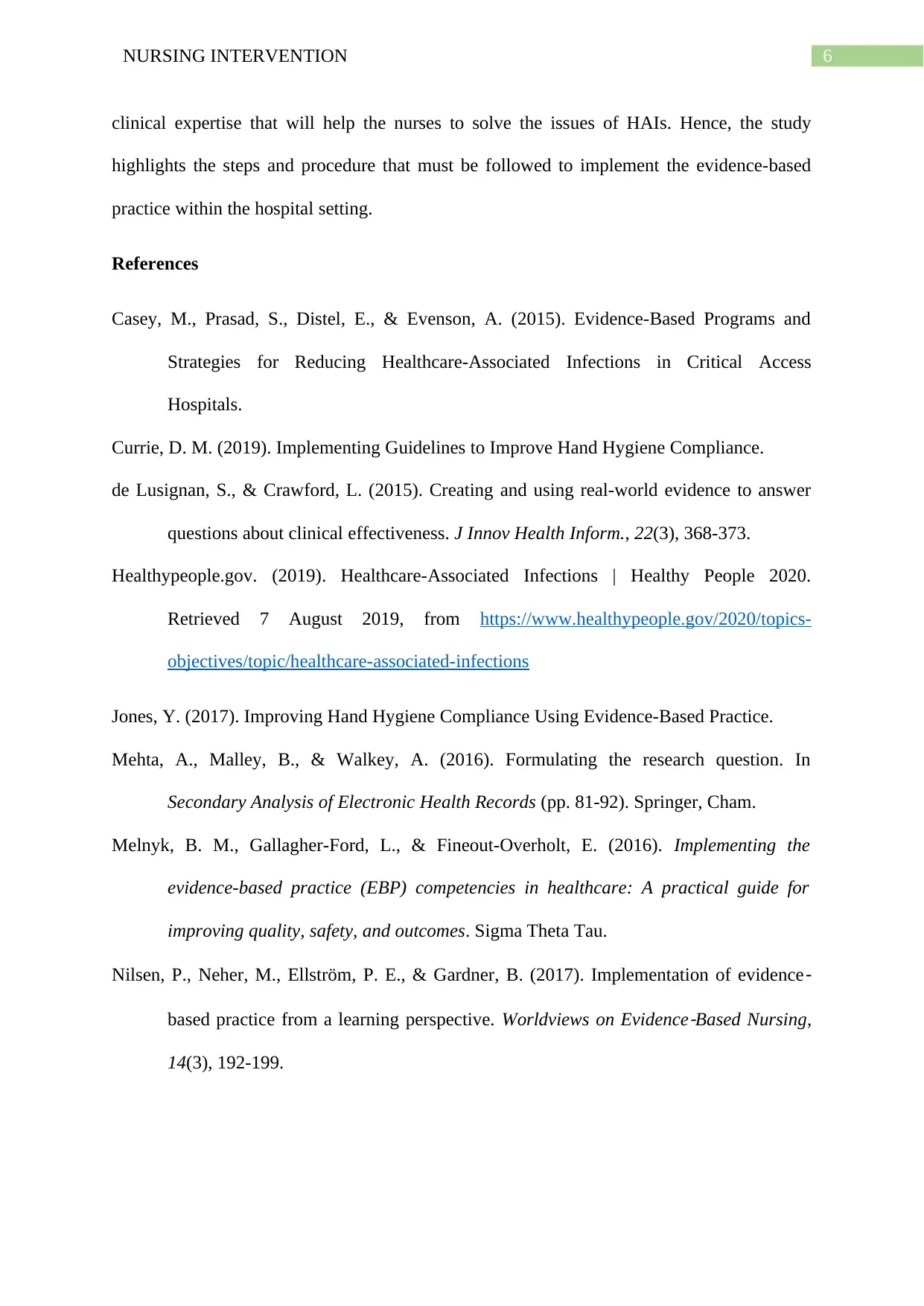
6NURSING INTERVENTION
clinical expertise that will help the nurses to solve the issues of HAIs. Hence, the study
highlights the steps and procedure that must be followed to implement the evidence-based
practice within the hospital setting.
References
Casey, M., Prasad, S., Distel, E., & Evenson, A. (2015). Evidence-Based Programs and
Strategies for Reducing Healthcare-Associated Infections in Critical Access
Hospitals.
Currie, D. M. (2019). Implementing Guidelines to Improve Hand Hygiene Compliance.
de Lusignan, S., & Crawford, L. (2015). Creating and using real-world evidence to answer
questions about clinical effectiveness. J Innov Health Inform., 22(3), 368-373.
Healthypeople.gov. (2019). Healthcare-Associated Infections | Healthy People 2020.
Retrieved 7 August 2019, from https://www.healthypeople.gov/2020/topics-
objectives/topic/healthcare-associated-infections
Jones, Y. (2017). Improving Hand Hygiene Compliance Using Evidence-Based Practice.
Mehta, A., Malley, B., & Walkey, A. (2016). Formulating the research question. In
Secondary Analysis of Electronic Health Records (pp. 81-92). Springer, Cham.
Melnyk, B. M., Gallagher-Ford, L., & Fineout-Overholt, E. (2016). Implementing the
evidence-based practice (EBP) competencies in healthcare: A practical guide for
improving quality, safety, and outcomes. Sigma Theta Tau.
Nilsen, P., Neher, M., Ellström, P. E., & Gardner, B. (2017). Implementation of evidence‐
based practice from a learning perspective. Worldviews on Evidence
‐Based Nursing,
14(3), 192-199.
clinical expertise that will help the nurses to solve the issues of HAIs. Hence, the study
highlights the steps and procedure that must be followed to implement the evidence-based
practice within the hospital setting.
References
Casey, M., Prasad, S., Distel, E., & Evenson, A. (2015). Evidence-Based Programs and
Strategies for Reducing Healthcare-Associated Infections in Critical Access
Hospitals.
Currie, D. M. (2019). Implementing Guidelines to Improve Hand Hygiene Compliance.
de Lusignan, S., & Crawford, L. (2015). Creating and using real-world evidence to answer
questions about clinical effectiveness. J Innov Health Inform., 22(3), 368-373.
Healthypeople.gov. (2019). Healthcare-Associated Infections | Healthy People 2020.
Retrieved 7 August 2019, from https://www.healthypeople.gov/2020/topics-
objectives/topic/healthcare-associated-infections
Jones, Y. (2017). Improving Hand Hygiene Compliance Using Evidence-Based Practice.
Mehta, A., Malley, B., & Walkey, A. (2016). Formulating the research question. In
Secondary Analysis of Electronic Health Records (pp. 81-92). Springer, Cham.
Melnyk, B. M., Gallagher-Ford, L., & Fineout-Overholt, E. (2016). Implementing the
evidence-based practice (EBP) competencies in healthcare: A practical guide for
improving quality, safety, and outcomes. Sigma Theta Tau.
Nilsen, P., Neher, M., Ellström, P. E., & Gardner, B. (2017). Implementation of evidence‐
based practice from a learning perspective. Worldviews on Evidence
‐Based Nursing,
14(3), 192-199.
Paraphrase This Document
Need a fresh take? Get an instant paraphrase of this document with our AI Paraphraser
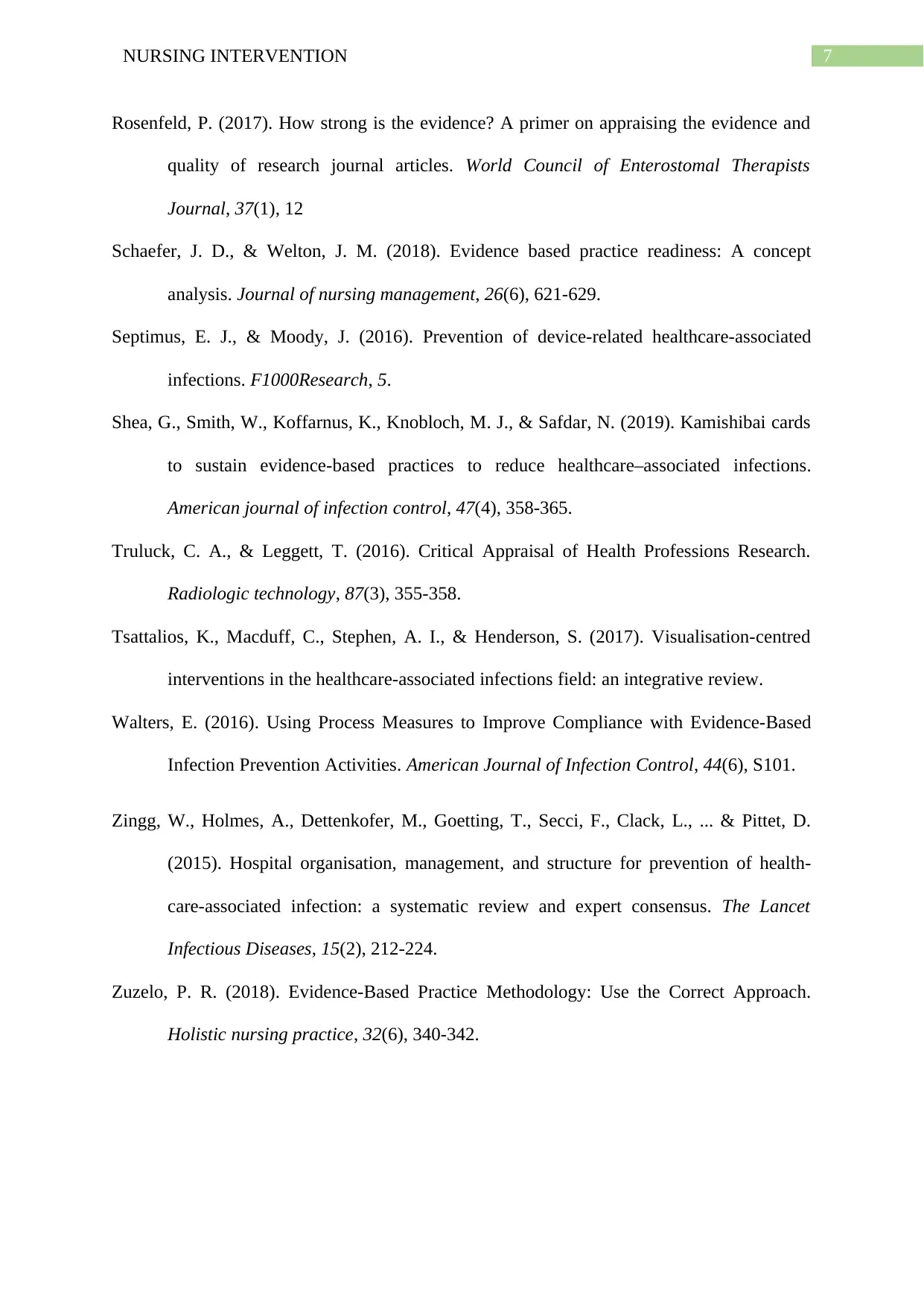
7NURSING INTERVENTION
Rosenfeld, P. (2017). How strong is the evidence? A primer on appraising the evidence and
quality of research journal articles. World Council of Enterostomal Therapists
Journal, 37(1), 12
Schaefer, J. D., & Welton, J. M. (2018). Evidence based practice readiness: A concept
analysis. Journal of nursing management, 26(6), 621-629.
Septimus, E. J., & Moody, J. (2016). Prevention of device-related healthcare-associated
infections. F1000Research, 5.
Shea, G., Smith, W., Koffarnus, K., Knobloch, M. J., & Safdar, N. (2019). Kamishibai cards
to sustain evidence-based practices to reduce healthcare–associated infections.
American journal of infection control, 47(4), 358-365.
Truluck, C. A., & Leggett, T. (2016). Critical Appraisal of Health Professions Research.
Radiologic technology, 87(3), 355-358.
Tsattalios, K., Macduff, C., Stephen, A. I., & Henderson, S. (2017). Visualisation-centred
interventions in the healthcare-associated infections field: an integrative review.
Walters, E. (2016). Using Process Measures to Improve Compliance with Evidence-Based
Infection Prevention Activities. American Journal of Infection Control, 44(6), S101.
Zingg, W., Holmes, A., Dettenkofer, M., Goetting, T., Secci, F., Clack, L., ... & Pittet, D.
(2015). Hospital organisation, management, and structure for prevention of health-
care-associated infection: a systematic review and expert consensus. The Lancet
Infectious Diseases, 15(2), 212-224.
Zuzelo, P. R. (2018). Evidence-Based Practice Methodology: Use the Correct Approach.
Holistic nursing practice, 32(6), 340-342.
Rosenfeld, P. (2017). How strong is the evidence? A primer on appraising the evidence and
quality of research journal articles. World Council of Enterostomal Therapists
Journal, 37(1), 12
Schaefer, J. D., & Welton, J. M. (2018). Evidence based practice readiness: A concept
analysis. Journal of nursing management, 26(6), 621-629.
Septimus, E. J., & Moody, J. (2016). Prevention of device-related healthcare-associated
infections. F1000Research, 5.
Shea, G., Smith, W., Koffarnus, K., Knobloch, M. J., & Safdar, N. (2019). Kamishibai cards
to sustain evidence-based practices to reduce healthcare–associated infections.
American journal of infection control, 47(4), 358-365.
Truluck, C. A., & Leggett, T. (2016). Critical Appraisal of Health Professions Research.
Radiologic technology, 87(3), 355-358.
Tsattalios, K., Macduff, C., Stephen, A. I., & Henderson, S. (2017). Visualisation-centred
interventions in the healthcare-associated infections field: an integrative review.
Walters, E. (2016). Using Process Measures to Improve Compliance with Evidence-Based
Infection Prevention Activities. American Journal of Infection Control, 44(6), S101.
Zingg, W., Holmes, A., Dettenkofer, M., Goetting, T., Secci, F., Clack, L., ... & Pittet, D.
(2015). Hospital organisation, management, and structure for prevention of health-
care-associated infection: a systematic review and expert consensus. The Lancet
Infectious Diseases, 15(2), 212-224.
Zuzelo, P. R. (2018). Evidence-Based Practice Methodology: Use the Correct Approach.
Holistic nursing practice, 32(6), 340-342.

8NURSING INTERVENTION
1 out of 9
Related Documents
Your All-in-One AI-Powered Toolkit for Academic Success.
+13062052269
info@desklib.com
Available 24*7 on WhatsApp / Email
![[object Object]](/_next/static/media/star-bottom.7253800d.svg)
Unlock your academic potential
© 2024 | Zucol Services PVT LTD | All rights reserved.





